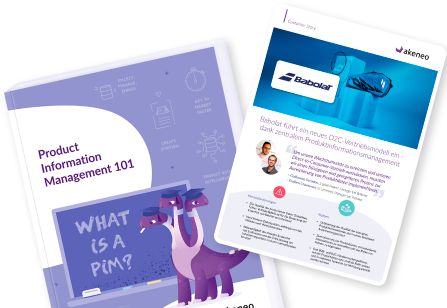Dec 15, 2022
6 min to read
Discover the differences and similarities between PIM and MDM, and how a PIM's focus on marketers can work with data from an MDM to drive brand value through product experiences

Companies exploring Product information Management (PIM) solutions often find themselves directed, through marketing and sales activities or internal stakeholders, to also explore Master Data Management (MDM) solutions. This isn’t surprising considering that on the surface these two software offerings appear to serve similar purposes within the data ecosystem.
Further complicating the discussion is that PIM is actually considered a specialized subcategory of MDM, and in recent years, some MDM vendors have begun trying to blur the distinction between the two systems. So let’s take a look at both to understand what makes them different and how PIM’s deep focus on marketers and their ability to drive brand value through product experiences makes them distinct from MDMs and an important offering for any retailer.
Master Data Management (MDM) is a category of software that centralizes and standardizes different data types and processes from multiple systems within an enterprise to build a “Master” record. Modern enterprises include dozens of disjointed systems that store critical Customer, Product, Supplier, Location, and Employee information in both structured and unstructured formats.
MDM platforms are IT driven solutions that bring harmony to this chaotic ecosystem by synchronizing and standardizing data across the entire ecosystem to provide a golden record that eliminates the potential for redundancy, duplication, and miscommunication. This stewardship over the entire enterprise’s data makes it a valuable tool for Business Intelligence (BI), the establishment of data policies and guidelines, regulatory compliance, and improving operational efficiencies.
Product Information Management (PIM) is considered a subcategory of MDM but differentiates itself by limiting its scope to being the Master for just Product information. PIM solutions are business driven applications that provide marketers a single place to collect, manage, translate, and enrich product information and media to create catalogs that can be quickly distributed to multiple sales channels and markets.
PIM systems offer robust support for omnichannel commerce by providing a wide range of connectivity solutions for eCommerce platforms, marketplaces, mobile apps, and social media. PIM software’s focus on Product Experience makes it critical to companies looking to ensure their brand provides a consistent high-quality experience across all customer touchpoints.
The benefits of PIM can be measured in higher conversion rates, lower return rates, and faster time to market for new products.
In the past, technical product information compiled in an MDM from supplier feeds, data hubs, or internal systems (PLM/ERP) may have been sufficient, but the rapidly evolving demands of digital commerce require more. Companies must increasingly be equipped to provide compelling, high-quality, and contextualized product information to a wide-range of customer touchpoints at a moment’s notice.
Product information can no longer be treated as a commodity; it is an important differentiator in the digital world, a business function ruled by marketers and merchandisers who collaborate with a wide range of internal teams and external partners and suppliers to deliver technical, visual, instructional, and emotional product information that is localized for and compliant with international markets. It is PIM software’s capacity to support these requirements that have made it a distinct and rapidly growing software category.
MDM and PIM platforms serve distinct but complementary functions within a business ecosystem, and many enterprises use both systems. MDM platforms can feed core product information aggregated from across the ecosystem into a PIM system. This information is then tailored and enhanced by marketers and combined with assets within the PIM before being distributed across all of a company’s sales channels.
When companies don’t have an MDM solution, PIM software can be a much faster and cheaper way to cleanse and govern product information to support digital commerce activities, though they make poor MDM substitutes when it comes to managing an entire company’s data management needs. For companies that do already have an MDM, the addition of a PIM platform gives their marketers a better place to build superior product experiences with support for digital commerce.
There is sometimes a temptation to forgo PIM software in favor of the “all-in-one” solution that MDM platforms appear to offer. Companies that go down this path tend to do so because of an underappreciation of the importance of quality product information to the business. From their perspective, products are simple lists of attributes attached to a SKU to describe the basic technical information about a product (height, weight, generic color etc.). And when this is the extent of your Product Information, it does seem only logical to consolidate it along with all the other 0’s and 1’s within an MDM.
But product information is much too important to be treated in this manner, because ultimately product information is critical in driving customer experience. We must consider this human element and provide a compelling experience to customers as they prepare to make that buying decision! Consolidating, reducing, and standardizing our sales data in an MDM makes sense, but do we really want to manage our customer’s product experiences the same way we handle last month’s invoices?
MDM rarely contains media describing the product, such as images and video, or marketing material. Thus, product master data needs further enhancement. This is the role of a product information management solution.
When integrating an MDM system to a PIM system, establish a single source of truth for each data field and determine who can access and manipulate what within each system. Bring only relevant customer-facing information from the MDM into the PIM and determine how frequently the data needs to be updated.
Core product information is often populated from the MDM into the PIM, enriched by the marketing team, and then passed back into the MDM for reporting and dissemination. API-based integrations are preferred.
PIM and MDM platforms are distinct but complementary technologies that both play an important role within a company’s ecosystem. While MDM platforms provide a powerful but resource intensive solution for IT teams to provide governance, reporting, and standardization across the entire enterprise, they can’t build compelling product experiences.
Only Marketers, empowered to collaborate in a PIM platform engineered specifically for their needs, can provide the high quality, differentiated product experiences modern commerce demands.
Don’t treat product information as just another piece of data to be managed, nurture it in a PIM and turn it into a competitive advantage to drive sales and unlock growth.
Sign up for our newsletter and stay ahead of the curve on everything you need to know about product information management, product experience management and how to unlock growth for your organization.
